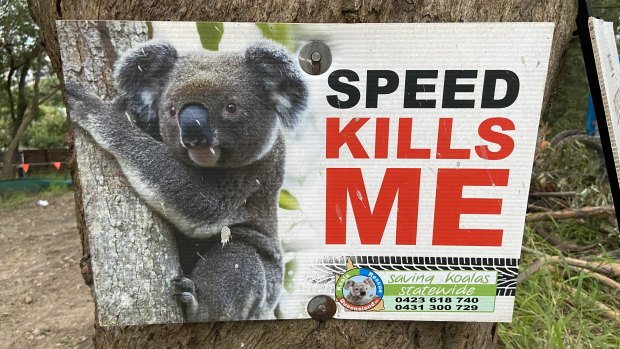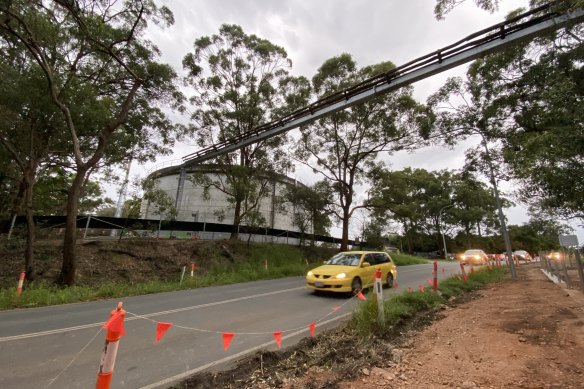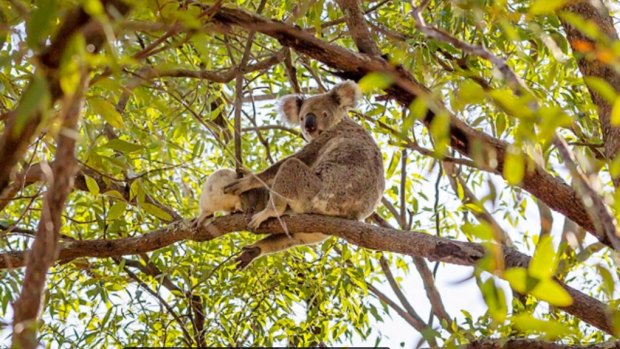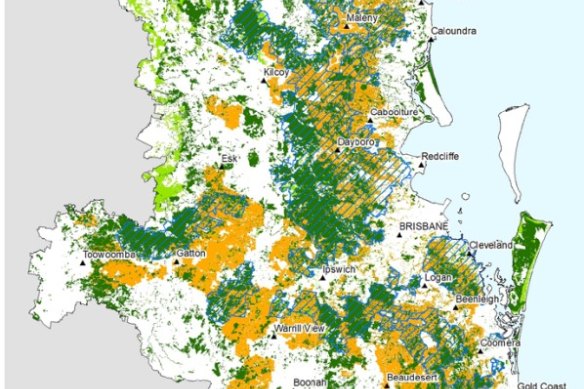This was published 2 years ago
Why the numbers in Queensland’s new koala report just don’t add up
By Tony Moore
A log bridge for koalas, touted as the nation’s first, might help the leaf-loving locals cross Boundary Road in Brisbane’s south, but a much greater threat looms over the marsupials’ habitat.
With advice from koala experts, the log bridge is being built at Coorparoo by Brisbane City Council because 20 koalas have died after being hit by cars there in the past five years.

A report into the first year of Queensland’s new five-year Koala Conservation Strategy shows hits, complications and misses.Credit: Tony Moore
But the annual report of the first year of the five-year South East Queensland Koala Conservation Strategy shows a more complex problem involving the habitat that koalas need to survive.
Since mid-2020, councils no longer have control of koala populations in south-east Queensland.
The state government now co-ordinates koala protection under the five-year, $4.48 million Koala Conservation Strategy, building relationships with universities, councils and conservation trusts.
The log bridge is a result, with “koala fences” stretching hundreds of metres along Boundary Road.

Is this the country’s first overhead koala log bridge? It is being built at Coorparoo because 20 koalas have died there after being hit by cars.Credit: Tony Moore
The Department of Transport and Main Roads said 60 kilometres of koala fencing had been built in the state’s south-east, with trials of “koala safety shields” on the Pacific Motorway.
In 2021, the federal government’s Threatened Species Scientific Sub Committee found only 7752 koalas would live in the wild in south-east Queensland by the 2032 Olympic Games. In 1992, there were 32,288 koalas.
The first annual report released as part of the strategy, charting the state government’s achievements against four goals, was released quietly in Rockhampton on Tuesday.
In February 2020, former environment minister Leeanne Enoch said the Koala Conservation Strategy covered 690,000 hectares of koala habitat, “including 577,000 hectares of Koala Priority Areas”. She said this also included areas identified for rehabilitation.

Since mid-2020, councils no longer have control of koala populations in south-east Queensland.
But the report handed down this week showed there were “332,278 hectares within Koala Priority Areas”.
However, Catherine George, manager of the Department of Environment and Science’s Koala Policy and Oversight team, said the 332,278 hectares in the annual report referred to a smaller subset of Core Koala Habitat within the Koala Priority Area.
She said it should be compared with 330,660 hectares from the foreword to the February 2020 koala strategy - which also referred to Core Koala Habitat - and not the 577,000 hectares in Ms Enoch’s media statement.
That amounts to a 0.48 per increase in Core Koala Habitat within the Koala Priority Areas where land clearing protections are strictest and clearing is totally banned.
Land clearing is banned in other sections of Koala Priority Areas, but exemptions are allowed.
George said the larger category of Koala Priority Area had not been “lost”, but included non-koala habitat and areas which were being revegetated. She said annual mapping also changed the land in different categories.
“Koala priority areas also have areas that don’t contain any koala habitat, but are the most suitable areas for habitat restoration activities,” she said.
“So they are the areas that are the areas that are going to have the most likely level of (koala recovery) success.”

Queensland Koala Habitat maps showing smaller Core Koala Habitat and larger Koala Priority Area zones which are updated annually.Credit: Department of Environment and Science.
Queensland Conservation Council koala specialist Jon Ferguson said he was worried by the apparent decline in habitat.
“The difference in the numbers is very concerning,” he said. “However, because they mention mapping refinements, we need to work out what those refinements are.”
Wins and losses in the first report card of the SEQ Koala Conservation Strategy
Goal 1: Setting targets for “stabilising” the shocking decline in koala numbers.
- Outcome: No major koala counts have been completed. A network of 62 sites has been chosen around south-east Queensland to establish a baseline population from 2022.
- Outcome: 130 koalas were identified at those sites between August 2020 and July 2021.
Goal 2: Achieving a net gain in core koala habitat area.
- Outcome: The total area of koala habitat in SEQ has increased by 4 per cent to 714,040 hectares from 690,000ha.
- Outcome: Core Koala Habitat -within the Koala Priority Areas - has increased 0.48 per cent from 330,,600ha in 2020 to 332,278ha in September 2021.
- Outcome: A decline of 25,500 hectares of locally refined koala habitat is attributed to more defined koala habitat mapping being used to more accurately describe critical habitat.
Goal 3: Commencing work to restore 10,000 hectares of koala habitat.
- Outcome: 255 hectares of koala habitat around Flinders Peak has been revegetated.
- Outcome: 170-hectare project to plant 150,000 koala trees around Lake Wivenhoe.
- Outcome: A revegetation partnership signed with the 2000-hectare working Aroonga cattle property in the Little Liverpool Range, south-west of Ipswich.
Goal 4: Ways to reduce threats to wild koalas.
- Outcome: A new QKoala App is under development to track sightings.
- Outcome: A dog awareness program developed across SEQ.
- Outcome: Koala safety shields installed on the M1.
- Outcome: A new state government planning code – the State Code 25: Development in SEQ Koala Habitat Areas – introduced to reduce koala habitat loss.
- Outcome: Review of Queensland’s koala habitat land offset scheme under way.
Opposition environment spokesman Sam O’Connor said, “on the surface, the figures just don’t add up”. He questioned whether the 2020 figure from Enoch was wrong.
The head of the Australian Koala Foundation, Deb Tabart, said the complicated land classifications frustrated genuine inquiries.
“They have all these land classifications, so they can obfuscate, and developers can get access to prime land,” she said.
An experienced environmental planner said identifying Koala Priority Areas in which the clearing of koala habitat was banned was a “fantastic step”.
However, the planner claimed developers were regularly granted “avoidances” and simply cleared koala habitat through a “recognised loophole” in the Koala Conservation Strategy.
“A developer can just say, ‘it will reduce my yield by two houses. I can’t avoid that tree or my yield will be reduced’, and that is a reason to say, ‘OK, we are going to clear that koala habitat’.
“And that is what happens.”